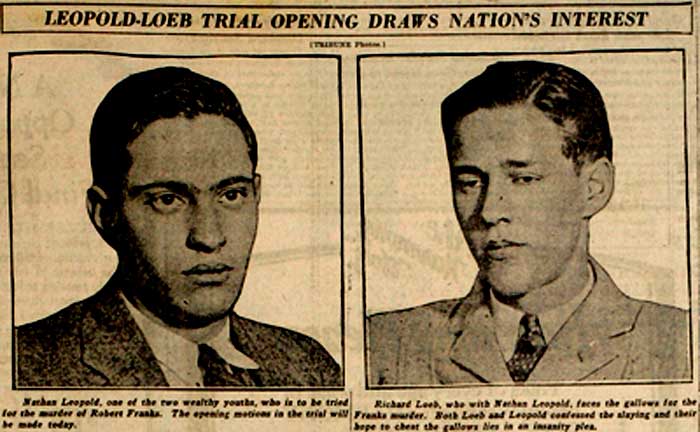An American Tragedy: Retelling the Leopold-Loeb Story in Popular Culture has just been posted by
Edward Larson, Pepperdine University School of L

aw. It appears in the American Journal of Legal History (April 2008-2010). Here’s the abstract:
This Article scans the cultural history of an American tragedy: the Leopold and Loeb murder case. In what has widely been referred to as "the crime of the century," teenagers Richard Loeb and Nathan F. Leopold, Jr., under the counsel of the experienced and successful defense attorney Clarence Darrow, pled guilty to the 1924 abduction and murder of Bobby Franks, a child of a wealthy Chicago family. Due to Darrow's advocacy, both defendants were spared the death penalty, and given life sentences instead. Sensational details about the crime, the suspects, and the criminal proceedings were enthusiastically reported by the six daily newspapers published in Chicago during this time.
This Articles focuses on the evolution of several distinct personas of the suspected killers, three of which were created by the print media as they covered the story from confession to sentencing. One of the personas developed by newspaper articles was that of both suspects, but particularly Leopold, as self-conceived Nietzschean supermen, exempt from normal moral, ethical, and legal standards. Later, this persona was more fully developed in popular novels and major motion pictures based on the Leopold and Loeb story. The second persona developed by the print media is that of the precocious teenage thrill-seekers. This persona, which was seen to exemplify the indulged, immoral youth culture of the 1920s that was enjoyed by wealthy young men, was also later developed in artistic interpretations of the story of the crime. The print media also presented a third persona in its stories about the criminal proceedings against Leopold and Loeb. With the assistance of East Coast alienists who adopted a Freudian approach to psychology, as well as two physicians, defense attorney Darrow created and developed this third persona during the hearing - that of deeply disturbed youth who were emotionally unable to control their actions. Darrow used this image of Leopold and Loeb as deeply troubled boys to persuade the judge to not sentence the defendants to death. It has reappeared in later artistic presentations of the episode.
In addition to the three personas developed in the print media, the Article also discusses two other personas that have evolved since the original events took place in 1924. Toward the end of the twentieth century, the sexual aspect of Leopold's and Loeb's relationship was subject to increased scrutiny. With this came the development, through plays, movies and other artistic portrayals of the events leading up to the crime, of a gay persona for both Leopold and Loeb; particularly, a persona of repressed lovers. Finally, Leopold himself, in telling his own story through magazine articles and a popular autobiography, created for himself a new persona: that of a model prisoner who deserved parole.
The highly publicized crime, prosecution, and punishment of Leopold and Loeb have served as a seemingly endless source of material and inspiration for American writers, dramatists, and social commentators. Because of continued interest in these events, they, together with attorney Clarence Darrow, have remained celebrities whose stories have inspired novelists, playwrights, poets, essayist and artists well into the new century. Perhaps more than any other trial in American history, the Leopold and Loeb case has served as an ongoing inspiration for the American imagination.
Image.
 aw. It appears in the American Journal of Legal History (April 2008-2010). Here’s the abstract:
aw. It appears in the American Journal of Legal History (April 2008-2010). Here’s the abstract: